Abstract
OBJECTIVE: To review the current research and formulate a rational approach to the cause, prevention and treatment of postdural puncture headache (PDPH). DATA SOURCES: Articles published from January 1980 to April 1992 were obtained through a search of MEDLINE and Index Medicus. Key reference articles published before 1980 were also reviewed. STUDY SELECTION: All pertinent studies were included and critically analysed. DATA SYNTHESIS: PDPH occurs when a slow leak of cerebrospinal fluid leads to contraction of the subarachnoid space and compensatory expansion of the pain-sensitive intracerebral veins. Female sex and an age between 20 and 40 years have been shown to be independent risk factors for PDPH, but pregnancy has not. The rate of PDPH is directly proportional to the diameter of the needle used and also depends on the design of the needle tip. Prophylactic epidural blood patching or saline infusion after dural puncture can decrease the incidence of PDPH, but both are invasive procedures. Intravenous caffeine sodium benzoate therapy effectively relieves PDPH, but the headache may recur. An epidural blood patch is an invasive but effective, permanent treatment for PDPH in most cases; resistant cases may respond to epidural saline infusion. CONCLUSION: The rate of PDPH after lumbar puncture can be minimized through strict attention to technique and the employment of a 25-gauge needle with the bevel parallel to the dural fibres. A reliable diagnosis and stepwise approach to treatment will minimize complications.
Full text
PDF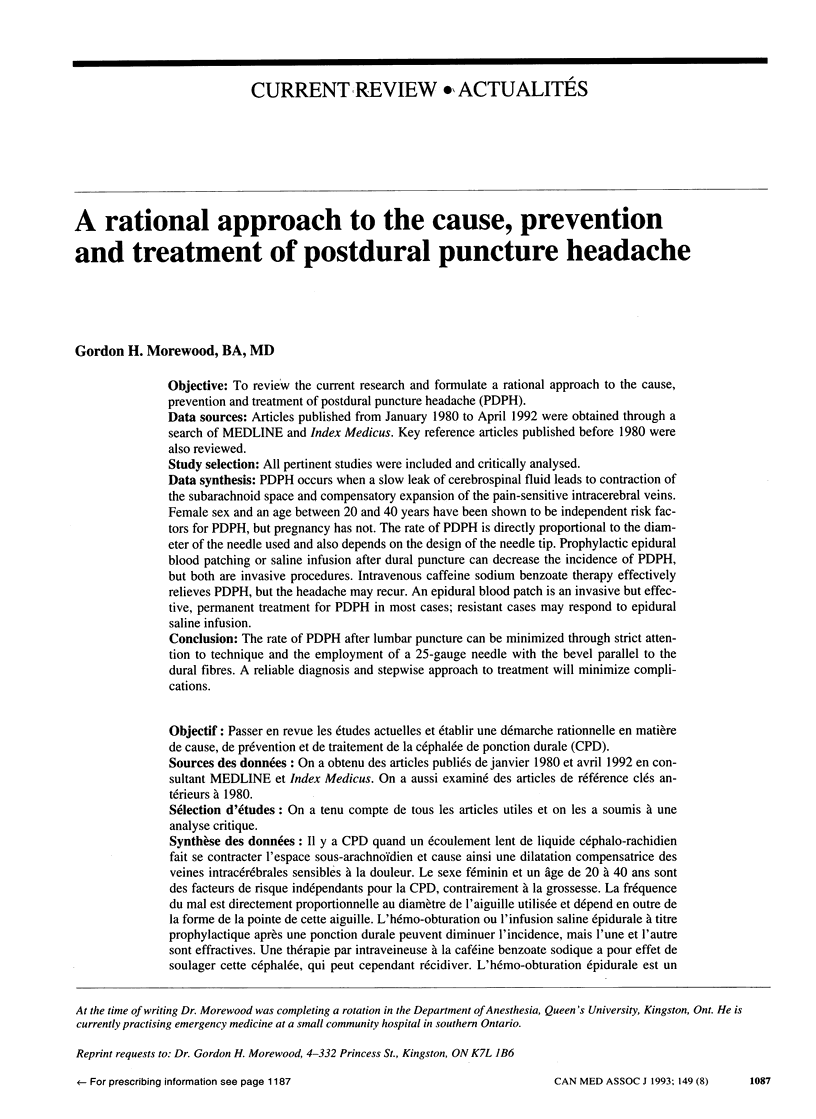
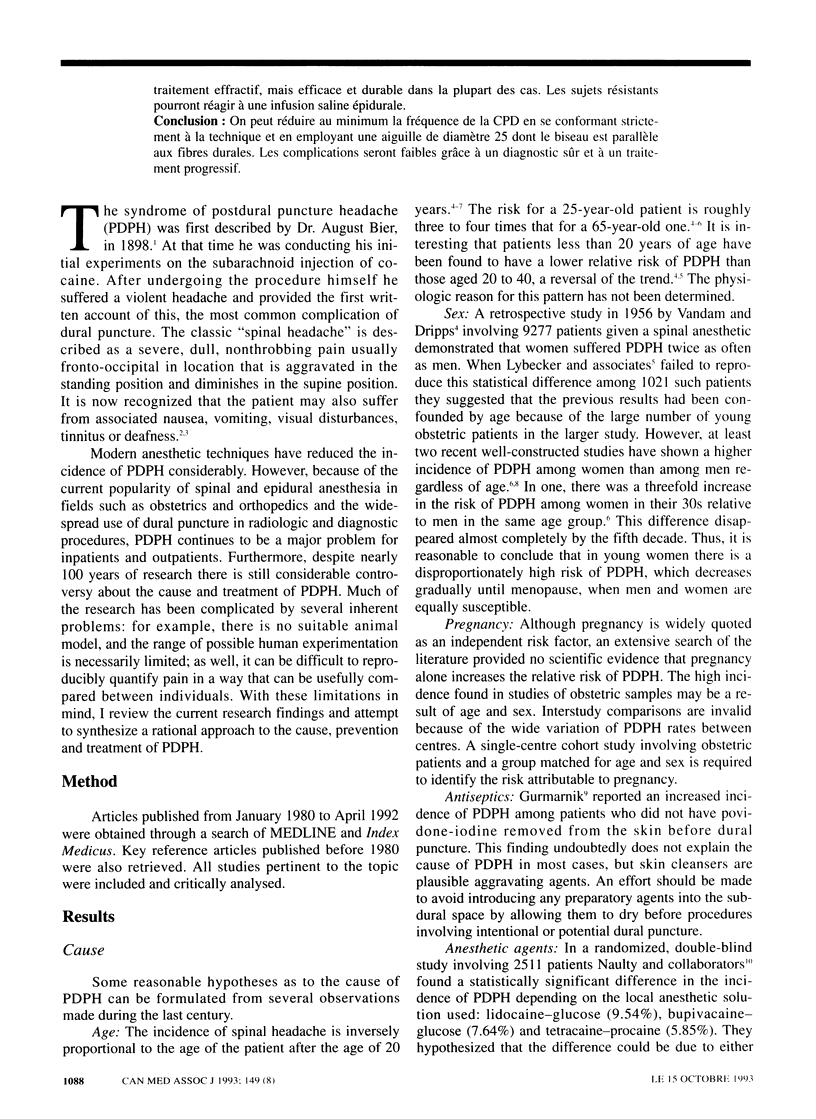

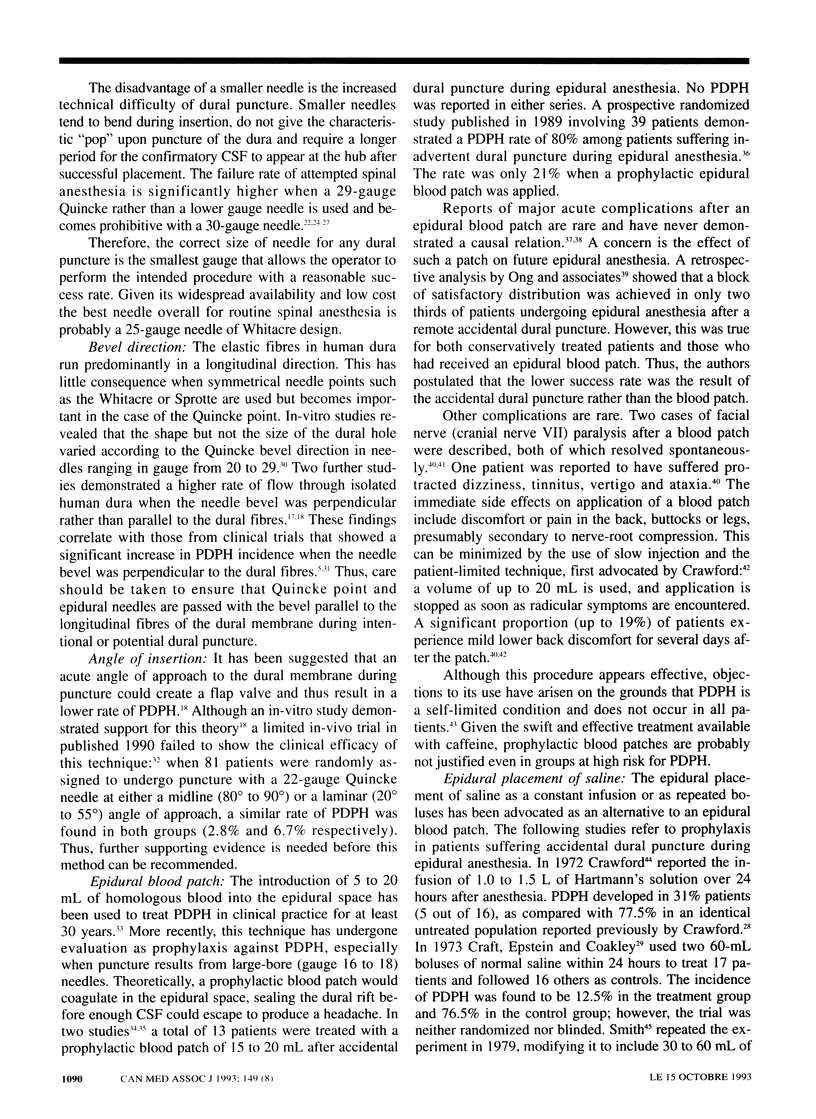
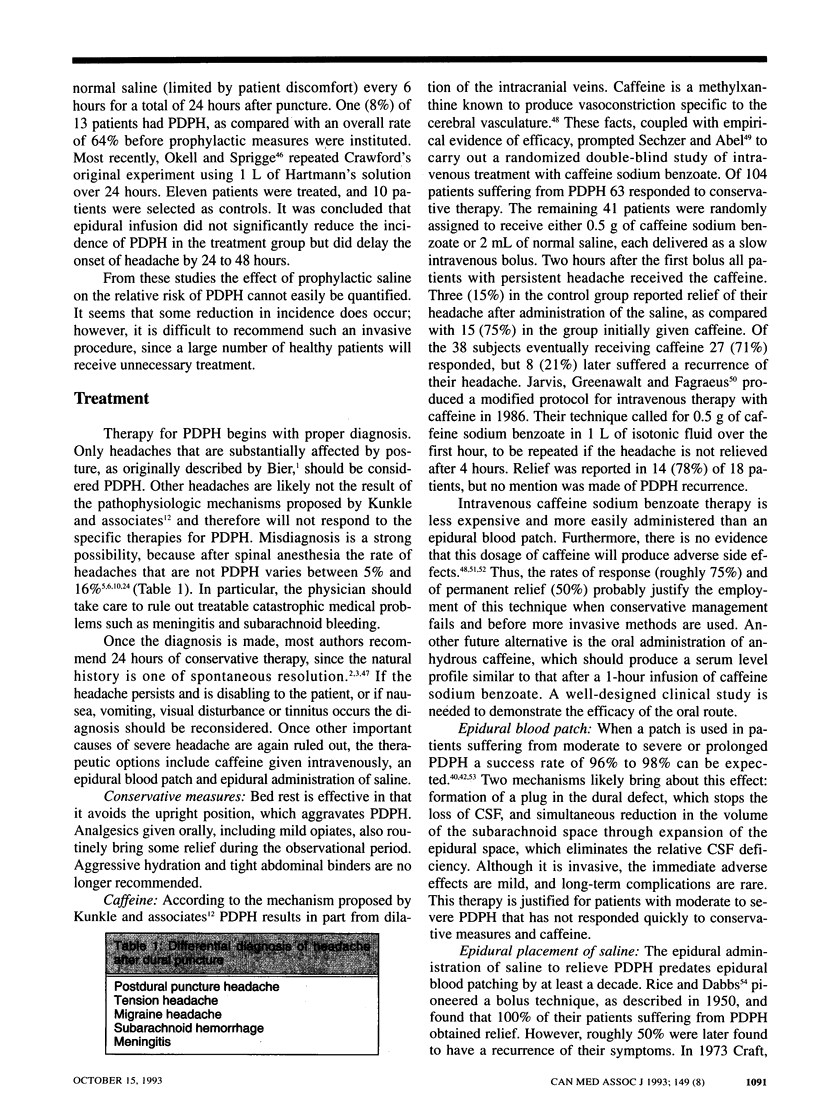

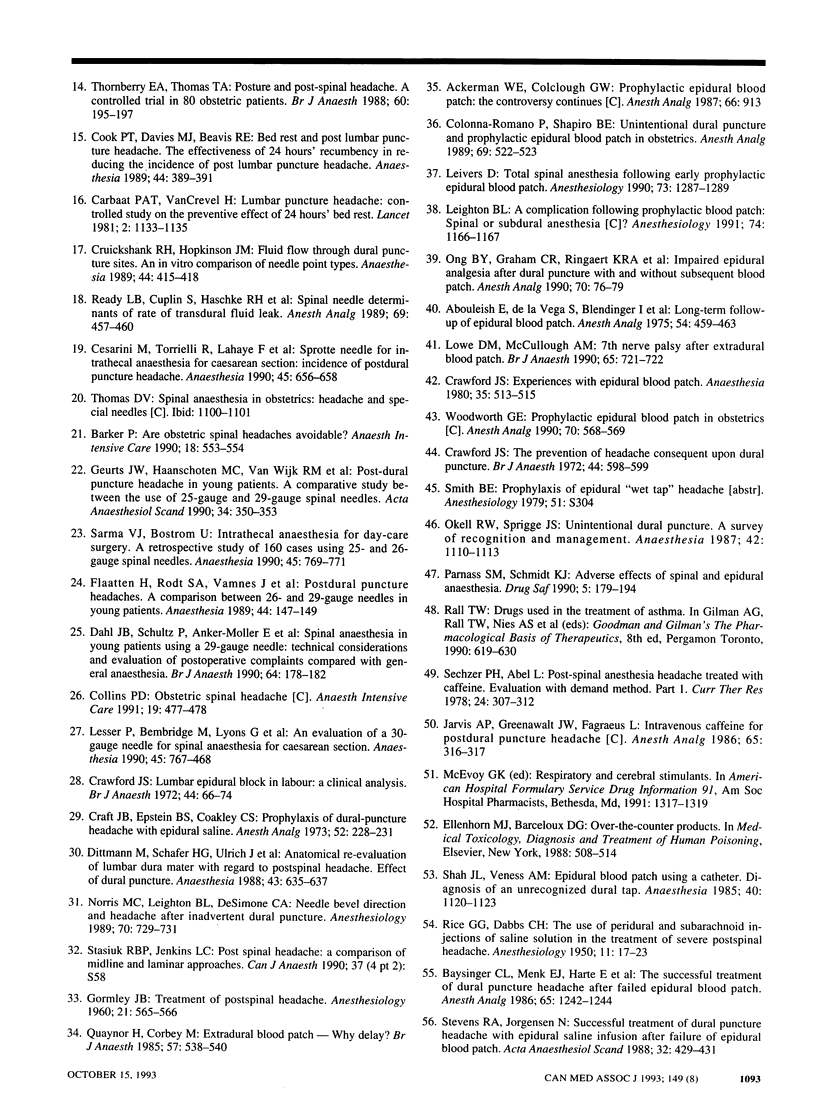
Selected References
These references are in PubMed. This may not be the complete list of references from this article.
- Abouleish E., Vega S., Blendinger I., Tio T. O. Long-term follow-up of epidural blood patch. Anesth Analg. 1975 Jul-Aug;54(4):459–463. doi: 10.1213/00000539-197554040-00012. [DOI] [PubMed] [Google Scholar]
- Ackerman W. E., Colclough G. W. Prophylactic epidural blood patch: the controversy continues. Anesth Analg. 1987 Sep;66(9):913–913. doi: 10.1213/00000539-198709000-00022. [DOI] [PubMed] [Google Scholar]
- Barker P. Are obstetric spinal headaches avoidable? Anaesth Intensive Care. 1990 Nov;18(4):553–554. doi: 10.1177/0310057X9001800426. [DOI] [PubMed] [Google Scholar]
- Baysinger C. L., Menk E. J., Harte E., Middaugh R. The successful treatment of dural puncture headache after failed epidural blood patch. Anesth Analg. 1986 Nov;65(11):1242–1244. [PubMed] [Google Scholar]
- Carbaat P. A., van Crevel H. Lumbar puncture headache: controlled study on the preventive effect of 24 hours' bed rest. Lancet. 1981 Nov 21;2(8256):1133–1135. doi: 10.1016/s0140-6736(81)90586-9. [DOI] [PubMed] [Google Scholar]
- Cesarini M., Torrielli R., Lahaye F., Mene J. M., Cabiro C. Sprotte needle for intrathecal anaesthesia for caesarean section: incidence of postdural puncture headache. Anaesthesia. 1990 Aug;45(8):656–658. doi: 10.1111/j.1365-2044.1990.tb14392.x. [DOI] [PubMed] [Google Scholar]
- Collins P. D. Obstetric spinal headache. Anaesth Intensive Care. 1991 Aug;19(3):477–478. [PubMed] [Google Scholar]
- Colonna-Romano P., Shapiro B. E. Unintentional dural puncture and prophylactic epidural blood patch in obstetrics. Anesth Analg. 1989 Oct;69(4):522–523. [PubMed] [Google Scholar]
- Cook P. T., Davies M. J., Beavis R. E. Bed rest and postlumbar puncture headache. The effectiveness of 24 hours' recumbency in reducing the incidence of postlumbar puncture headache. Anaesthesia. 1989 May;44(5):389–391. doi: 10.1111/j.1365-2044.1989.tb11334.x. [DOI] [PubMed] [Google Scholar]
- Craft J. B., Epstein B. S., Coakley C. S. Prophylaxis of dural-puncture headache with epidural saline. Anesth Analg. 1973 Mar;52(2):228–231. [PubMed] [Google Scholar]
- Crawford J. S. Experiences with epidural blood patch. Anaesthesia. 1980 May;35(5):513–515. doi: 10.1111/j.1365-2044.1980.tb03834.x. [DOI] [PubMed] [Google Scholar]
- Crawford J. S. Lumbar epidural block in labour: a clinical analysis. Br J Anaesth. 1972 Jan;44(1):66–74. doi: 10.1093/bja/44.1.66. [DOI] [PubMed] [Google Scholar]
- Crawford J. S. The prevention of headache consequent upon dural puncture. Br J Anaesth. 1972 Jun;44(6):598–600. doi: 10.1093/bja/44.6.598. [DOI] [PubMed] [Google Scholar]
- Cruickshank R. H., Hopkinson J. M. Fluid flow through dural puncture sites. An in vitro comparison of needle point types. Anaesthesia. 1989 May;44(5):415–418. doi: 10.1111/j.1365-2044.1989.tb11343.x. [DOI] [PubMed] [Google Scholar]
- Dahl J. B., Schultz P., Anker-Møller E., Christensen E. F., Staunstrup H. G., Carlsson P. Spinal anaesthesia in young patients using a 29-gauge needle: technical considerations and an evaluation of postoperative complaints compared with general anaesthesia. Br J Anaesth. 1990 Feb;64(2):178–182. doi: 10.1093/bja/64.2.178. [DOI] [PubMed] [Google Scholar]
- Dittmann M., Schäfer H. G., Ulrich J., Bond-Taylor W. Anatomical re-evaluation of lumbar dura mater with regard to postspinal headache. Effect of dural puncture. Anaesthesia. 1988 Aug;43(8):635–637. doi: 10.1111/j.1365-2044.1988.tb04145.x. [DOI] [PubMed] [Google Scholar]
- Flaatten H., Rodt S. A., Vamnes J., Rosland J., Wisborg T., Koller M. E. Postdural puncture headache. A comparison between 26- and 29-gauge needles in young patients. Anaesthesia. 1989 Feb;44(2):147–149. doi: 10.1111/j.1365-2044.1989.tb11167.x. [DOI] [PubMed] [Google Scholar]
- Flaatten H., Rodt S., Rosland J., Vamnes J. Postoperative headache in young patients after spinal anaesthesia. Anaesthesia. 1987 Feb;42(2):202–205. doi: 10.1111/j.1365-2044.1987.tb03001.x. [DOI] [PubMed] [Google Scholar]
- Geurts J. W., Haanschoten M. C., van Wijk R. M., Kraak H., Besse T. C. Post-dural puncture headache in young patients. A comparative study between the use of 0.52 mm (25-gauge) and 0.33 mm (29-gauge) spinal needles. Acta Anaesthesiol Scand. 1990 Jul;34(5):350–353. doi: 10.1111/j.1399-6576.1990.tb03101.x. [DOI] [PubMed] [Google Scholar]
- Jarvis A. P., Greenawalt J. W., Fagraeus L. Intravenous caffeine for postdural puncture headache. Anesth Analg. 1986 Mar;65(3):316–317. [PubMed] [Google Scholar]
- Leighton B. L. A complication following prophylactic blood patch: spinal or subdural anesthesia? Anesthesiology. 1991 Jun;74(6):1166–1167. doi: 10.1097/00000542-199106000-00046. [DOI] [PubMed] [Google Scholar]
- Leivers D. Total spinal anesthesia following early prophylactic epidural blood patch. Anesthesiology. 1990 Dec;73(6):1287–1289. doi: 10.1097/00000542-199012000-00038. [DOI] [PubMed] [Google Scholar]
- Lesser P., Bembridge M., Lyons G., Macdonald R. An evaluation of a 30-gauge needle for spinal anaesthesia for caesarean section. Anaesthesia. 1990 Sep;45(9):767–768. doi: 10.1111/j.1365-2044.1990.tb14451.x. [DOI] [PubMed] [Google Scholar]
- Lowe D. M., McCullough A. M. 7th nerve palsy after extradural blood patch. Br J Anaesth. 1990 Nov;65(5):721–722. doi: 10.1093/bja/65.5.721. [DOI] [PubMed] [Google Scholar]
- Lybecker H., Møller J. T., May O., Nielsen H. K. Incidence and prediction of postdural puncture headache. A prospective study of 1021 spinal anesthesias. Anesth Analg. 1990 Apr;70(4):389–394. doi: 10.1213/00000539-199004000-00008. [DOI] [PubMed] [Google Scholar]
- Naulty J. S., Hertwig L., Hunt C. O., Datta S., Ostheimer G. W., Weiss J. B. Influence of local anesthetic solution on postdural puncture headache. Anesthesiology. 1990 Mar;72(3):450–454. doi: 10.1097/00000542-199003000-00010. [DOI] [PubMed] [Google Scholar]
- Norris M. C., Leighton B. L., DeSimone C. A. Needle bevel direction and headache after inadvertent dural puncture. Anesthesiology. 1989 May;70(5):729–731. doi: 10.1097/00000542-198905000-00002. [DOI] [PubMed] [Google Scholar]
- Okell R. W., Sprigge J. S. Unintentional dural puncture. A survey of recognition and management. Anaesthesia. 1987 Oct;42(10):1110–1113. doi: 10.1111/j.1365-2044.1987.tb05181.x. [DOI] [PubMed] [Google Scholar]
- Ong B. Y., Graham C. R., Ringaert K. R., Cohen M. M., Palahniuk R. J. Impaired epidural analgesia after dural puncture with and without subsequent blood patch. Anesth Analg. 1990 Jan;70(1):76–79. doi: 10.1213/00000539-199001000-00013. [DOI] [PubMed] [Google Scholar]
- Parnass S. M., Schmidt K. J. Adverse effects of spinal and epidural anaesthesia. Drug Saf. 1990 May-Jun;5(3):179–194. doi: 10.2165/00002018-199005030-00003. [DOI] [PubMed] [Google Scholar]
- Quaynor H., Corbey M., Berg P. Spinal anaesthesia in day-care surgery with a 26-gauge needle. Br J Anaesth. 1990 Dec;65(6):766–769. doi: 10.1093/bja/65.6.766. [DOI] [PubMed] [Google Scholar]
- Quaynor H., Corbey M. Extradural blood patch--why delay? Br J Anaesth. 1985 May;57(5):538–540. doi: 10.1093/bja/57.5.538. [DOI] [PubMed] [Google Scholar]
- RICE G. G., DABBS C. H. The use of peridural and subarachnoid injections of saline solution in the treatment of severe postspinal headache. Anesthesiology. 1950 Jan;11(1):17-23, illust. doi: 10.1097/00000542-195001000-00003. [DOI] [PubMed] [Google Scholar]
- Rasmussen B. S., Blom L., Hansen P., Mikkelsen S. S. Postspinal headache in young and elderly patients. Two randomised, double-blind studies that compare 20- and 25-gauge needles. Anaesthesia. 1989 Jul;44(7):571–573. doi: 10.1111/j.1365-2044.1989.tb11444.x. [DOI] [PubMed] [Google Scholar]
- Ready L. B., Cuplin S., Haschke R. H., Nessly M. Spinal needle determinants of rate of transdural fluid leak. Anesth Analg. 1989 Oct;69(4):457–460. [PubMed] [Google Scholar]
- Reid J. A., Thorburn J. Headache after spinal anaesthesia. Br J Anaesth. 1991 Dec;67(6):674–677. doi: 10.1093/bja/67.6.674. [DOI] [PubMed] [Google Scholar]
- Sarma V. J., Boström U. Intrathecal anaesthesia for day-care surgery. A retrospective study of 160 cases using 25- and 26-gauge spinal needles. Anaesthesia. 1990 Sep;45(9):769–771. doi: 10.1111/j.1365-2044.1990.tb14452.x. [DOI] [PubMed] [Google Scholar]
- Shah J. L., Veness A. M. Epidural blood patch using a catheter. Diagnosis of an unrecognised dural tap. Anaesthesia. 1985 Nov;40(11):1120–1123. doi: 10.1111/j.1365-2044.1985.tb10616.x. [DOI] [PubMed] [Google Scholar]
- Stasiuk R. B., Jenkins L. C. Post spinal headache: a comparison of midline and laminar approaches. Can J Anaesth. 1990 May;37(4 Pt 2):S58–S58. [PubMed] [Google Scholar]
- Stevens R. A., Jorgensen N. Successful treatment of dural puncture headache with epidural saline infusion after failure of epidural blood patch. Case report. Acta Anaesthesiol Scand. 1988 Jul;32(5):429–431. doi: 10.1111/j.1399-6576.1988.tb02760.x. [DOI] [PubMed] [Google Scholar]
- Thornberry E. A., Thomas T. A. Posture and post-spinal headache. A controlled trial in 80 obstetric patients. Br J Anaesth. 1988 Feb;60(2):195–197. doi: 10.1093/bja/60.2.195. [DOI] [PubMed] [Google Scholar]
- VANDAM L. D., DRIPPS R. D. Long-term follow-up of patients who received 10,098 spinal anesthetics; syndrome of decreased intracranial pressure (headache and ocular and auditory difficulties). J Am Med Assoc. 1956 Jun 16;161(7):586–591. doi: 10.1001/jama.1956.02970070018005. [DOI] [PubMed] [Google Scholar]
- Woodworth G. E. Prophylactic epidural blood patch in obstetrics. Anesth Analg. 1990 May;70(5):568–569. doi: 10.1213/00000539-199005000-00019. [DOI] [PubMed] [Google Scholar]


